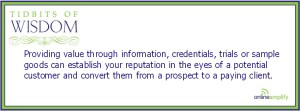What are your key conversion goals?
The question, which I ask of every client, seems like a no-brainer. The initial response: “To buy my product or services.” Of course; while we may love our work, most of us are in it (at least to some degree) to earn a living. But selling is a process, and convincing a prospective customer to purchase your services may take more than a single interaction or a direct navigation to the “buy now” button.
The conversion goal question should be considered not only from a big picture perspective, but also in the context of each page of your website. You spend time and resources on marketing to drive website traffic. Be purposeful. What action do you want a visitor to take when he lands on a particular page of your website?
When posing the question to clients, I offer prompts, such as:
- Sign up for my email newsletter
- Request a free sample or consultation
- Follow me on social media
- Download my free guide/eBook or other content
- Read my blog
Creating a sales funnel
The reason I use the prompts is to encourage a client to think about creating a sales funnel. Providing value through information, credentials, trials or sample goods can establish your reputation in the eyes of a potential customer and convert them from a prospect to a paying customer — and even to a possible referral source for additional customers.

If you’re marketing your business, you’re probably employing various strategies to drive visitors to your website. Each visitor who lands on a particular page is presented with navigation, content and design elements which should be strategically designed to guide them toward your desired conversion goals. How do you offer prospects the confidence that your product or service is the right one? Is it the free information sessions you offer? Your active Facebook page? Your client testimonials or your downloadable eBook or user guide?
Consider this example
Perhaps your blog is particularly informative. It demonstrates your expertise and your ability to explain complicated concepts in an understandable way. Your research shows that visitors who view the blog spend longer on your website and frequently contact you for a consultation.
You know that driving visitors to your blog can help to transform would-be clients into paid customers. One way to increase blog views is to use a blog feed on your Home page, offering a direct link to your blog landing page or particular posts. Content management systems like WordPress offer this functionality via packaged solutions called plugins or widgets.
By customizing the settings in a widget, you can specify which pages it will appear on, the content that’s displayed (such as particular posts) and the general look and feel (such as including blog post images and controlling the amount of preview text). Tell your website designer/developer what you’re looking for and encourage him or her to find the right widgets to support your conversion goals.

Above: An example of a blog teaser widget
Whether you are launching a new site or just seeking to optimize the effectiveness of your existing website, think carefully about your desired conversions and purposefully place relevant teaser images and content to move visitors toward achieving them.



One Comment